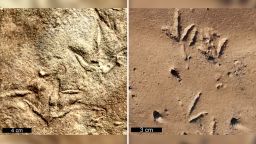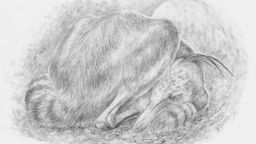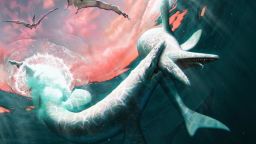Sign up for CNN’s Wonder Theory science newsletter. Explore the universe with news on fascinating discoveries, scientific advancements and more.
Ancient plant fossils that puzzled scientists have turned out not to be plants after all, new research has revealed.
Instead, the small round shapes bearing a leaflike pattern were once the shells of baby turtles that lived during the time of dinosaurs. Scientists have nicknamed the turtle species “Turtwig,” after a Pokémon character that is half-turtle, half-plant.
The discovery marks the first time baby turtle carapaces have been found in northwestern South America, according to the study authors.
The results of their research were published Thursday in the journal Palaeontologia Electronica.
“In the Pokémon universe, you encounter the concept of combining two or more elements, such as animals, machines, plants, etc.,” said lead author Héctor Palma-Castro, a graduate student of paleobotany at the National University of Colombia, in a statement.
“So, when you have a fossil initially classified as a plant that turns out to be a baby turtle, a few Pokémon immediately come to mind. In this case, Turtwig, a baby turtle with a leaf attached to its head.”
But it took some sleuthing to solve this paleontological mystery that began decades ago.
Wrong place, wrong time
It all started when Colombian priest Padre Gustavo Huertas discovered the fossils in the Paja Formation. The formation is part of one of Colombia’s geological heritage sites called the Marine Reptile Lagerstätte of the Ricaurte Alto.
Previous fossil discoveries from the site include dinosaurs, plesiosaurs, pliosaurs, ichthyosaurs, turtles and crocodile relatives called crocodylopmorphs dated from the Early Cretaceous Period, between 113 million and 132 million years ago.
Huertas collected fossils and rocks at the site, near the town of Villa de Leyva, from the 1950s to the 1970s. When he found the leaf-patterned rocks, he deemed them a fossil plant. Huertas went on to describe the specimens as Sphenophyllum colombianum in a 2003 study.
But other scientists were surprised to hear that the plant was discovered in northern South America and dated between 113 million and 132 million years ago. The now-extinct plant, once prevalent around the world, died out more than 100 million years earlier, according to the fossil record.
Previous research about the plant showed that its leaves were typically wedge-shaped with veins that radiated out from the base of the leaf.
The age and location of the fossils intrigued Palma-Castro and Fabiany Herrera, the assistant curator of paleobotany at the Negaunee Integrative Research Center at Chicago’s Field Museum of Natural History.
Herrera collects and studies plants from the Early Cretaceous Period (100.5 million to 145 million years ago) in northwestern South America, a part of the continent where little paleobotanical research takes place.
Both fossils, about 2 inches (5 centimeters) in diameter, were housed in collections at the National University of Colombia’s department of geosciences. As Herrera and Palma-Castro examined and photographed the fossils, they thought something seemed strange.
“When you look at it in detail, the lines seen on the fossils don’t look like the veins of a plant — I was positive that it was most likely bone,” said Herrera, the study’s senior author, in a statement.
Solving a fossil mystery
Herrera contacted his colleague Edwin-Alberto Cadena, a senior lecturer and paleontologist who studies turtles and other vertebrates at Del Rosario University in Bogotá, Colombia.
“They sent me the photos, and I said, ‘This definitely looks like a carapace’ — the bony upper shell of a turtle,” said Cadena, a study coauthor, in a statement. “I said, ‘Well, this is remarkable, because this is not only a turtle, but it’s also a hatchling specimen, it’s very, very small.’”
Cadena and one of his students, Diego Cómbita-Romero at the National University of Colombia, compared the fossils with the shells of other extinct and modern turtles.
“When we saw the specimen for the first time I was astonished, because the fossil was missing the typical marks on the outside of a turtle’s shell,” said study coauthor Cómbita-Romero in a statement. “It was a little bit concave, like a bowl. At that moment we realized that the visible part of the fossil was the other side of the carapace, we were looking at the part of the shell that is inside the turtle.”
During their analysis of the shells, the researchers determined that the turtles were about 1 year old at the most when they died.
As young turtles develop, their growth rates and sizes can vary, Cómbita-Romero said. But it’s rare to find remains of young turtles because the bones in their shells are so thin.
“These turtles were likely relatives of other Cretaceous species that were up to fifteen feet long, but we don’t know much about how they actually grew to such giant sizes,” Cadena said in a statement.
The researchers didn’t blame Huertas for mistakenly categorizing the fossils as plants. What he believed to be leaves and stems were the vertebrae and rib bones within a turtle’s shell.
“We resolved a small paleobotanical mystery, but more importantly, this study shows the need to re-study historical collections in Colombia. The Early Cretaceous is a critical time in land plant evolution,” Herrera said.
The research team next aims to uncover the forests that once grew in the region, he said.
“In paleontology, your imagination and capacity to be amazed are always put to the test,” Palma-Castro said. “Discoveries like these are truly special because they not only expand our knowledge about the past but also open a window to the diverse possibilities of what we can uncover.”
Article From & Read More ( Meet ‘Turtwig,’ an ancient turtle species once thought to be a plant - CNN )https://ift.tt/imB9cdJ
Science



No comments:
Post a Comment